1998 PONTIAC BONNEVILLE light
[x] Cancel search: lightPage 6 of 395
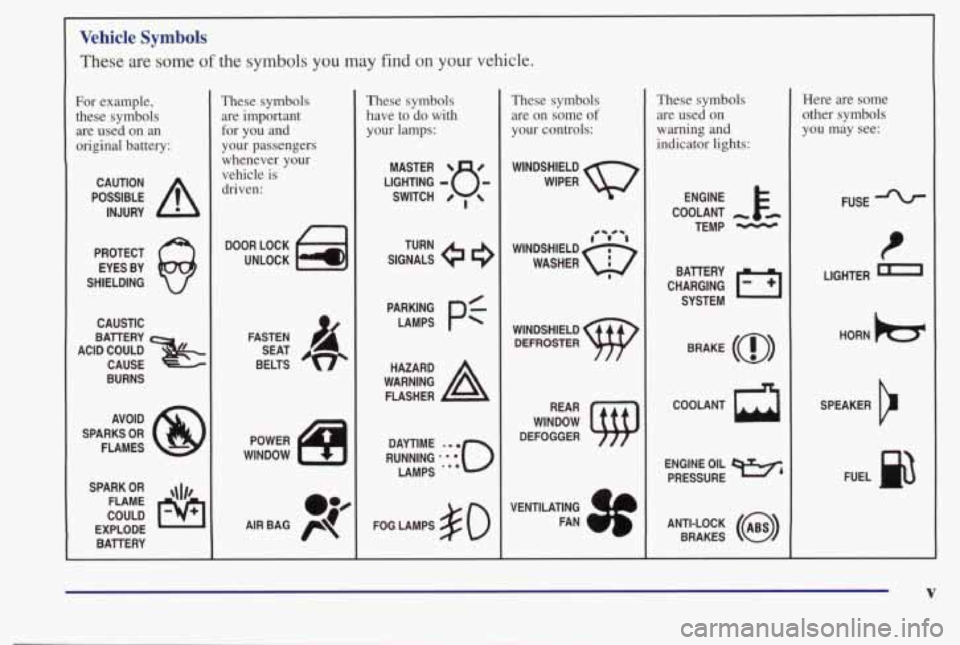
Vehicle Symbols
These are some of the symbols you may find on your vehicle.
For example,
these symbols are used on an
original battery:
POSSIBLE A
CAUTION
INJURY
PROTECT EYES BY
SHIELDING
Q
CAUSTIC
ACID COULD BAllERY
CAUSE -~~-. .
BURNS
AVOID
SPARKS
OR
FLAMES
SPARK
OR ,\I/,
COULD FLAME
EXPLODE BAllERY
I
These symbols are important
for you and
your passengers
whenever your
vehicle is
driven:
DOOR LOCK
UNLOCK
n
POWER
WINDOW
oJ4
AIR BAG p
These symbols
have to do with your lamps:
SIGNALS e3
TURN
FOG LAMPS
# 0
These symbols are on some
of
your controls:
WINDSHIELD
WIPER
WINDSHIELD
DEFROSTER
DEFOGGER
VENTILATING FAN
( rc?: A
These symbols are used on
warning
and
indicator lights:
COOLANT -
TEMP -
CHARGING I-1
BAllERY
SYSTEM
BRAKE
(a)
R
Here are some
other symbols
you may see:
FUSE
LIGHTER
n
HORN )b.
ENGINE OIL e,
PRESSURE
V
SPEAKER
b
FUEL
Page 13 of 395
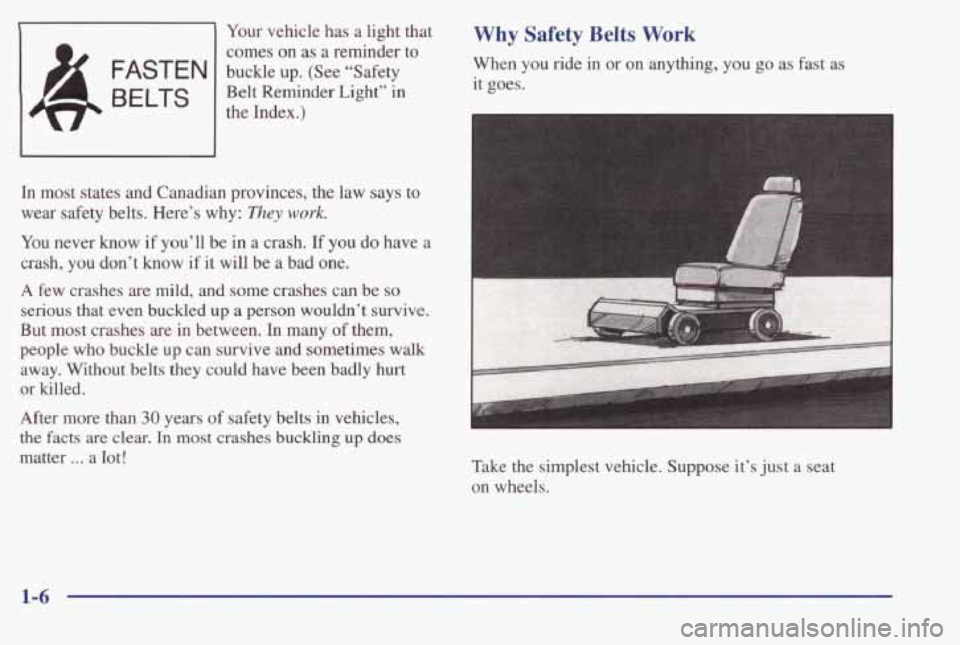
1 Your vehicle has a light that
& FASTEN I buckle up. (See “Safety comes on as a reminder to
LW
BELTS the
Index.)
Belt Reminder Light” in
In most states and Canadian provinces, the law says to
wear safety belts. Here’s why:
They work.
You never know if you’ll be in a crash. If you do have a
crash, you don’t know if it will be
a bad one.
A few crashes are mild, and some crashes can be so
serious that even buckled up a person wouldn’t survive.
But most crashes
are in between. In many of them,
people who buckle up can survive
and sometimes walk
away. Without belts they could have been badly hurt
or killed.
After more
than 30 years of safety belts in vehicles,
the facts are clear. In most crashes buckling up does
matter ... a lot!
Why Safety Belts Work
When you ride in or on anything, you go as fast as
it goes.
Take the simplest vehicle. Suppose it’s just a seat
on wheels.
1-6
Page 27 of 395
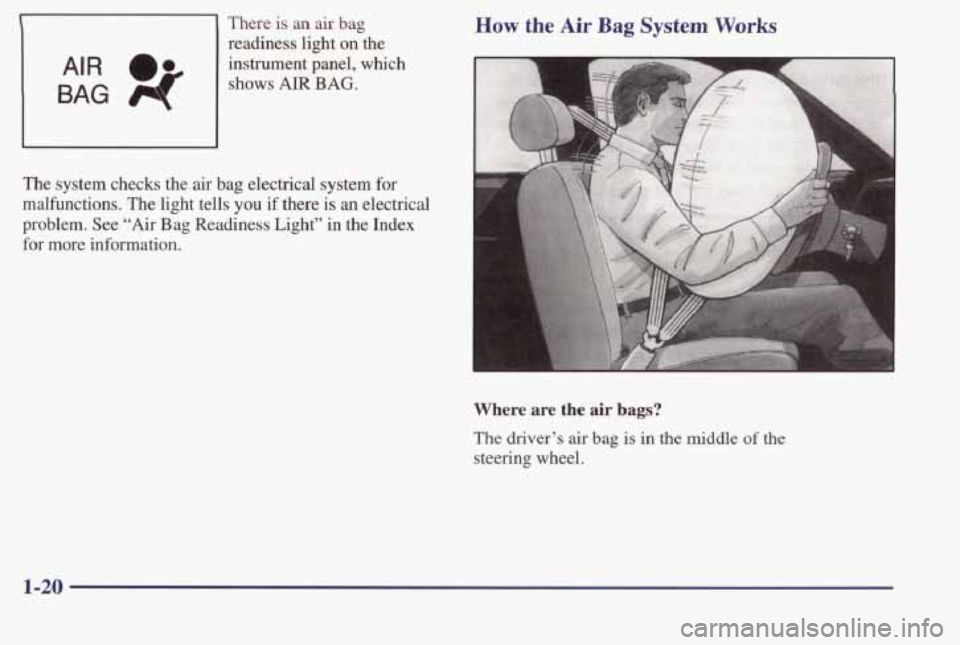
BAG 4
AIR 0.
There is an air bag
readiness light
on the
instrument panel, which
shows AIR BAG.
The system checks the air bag electrical system for
malfunctions. The light tells you if there is an electrical
problem. See
“Air Bag Readiness Light” in the Index
for more information.
How the Air Bag System Works
Where are the air bags?
The driver’s air bag is in the middle of the
steering wheel.
1-20
Page 56 of 395
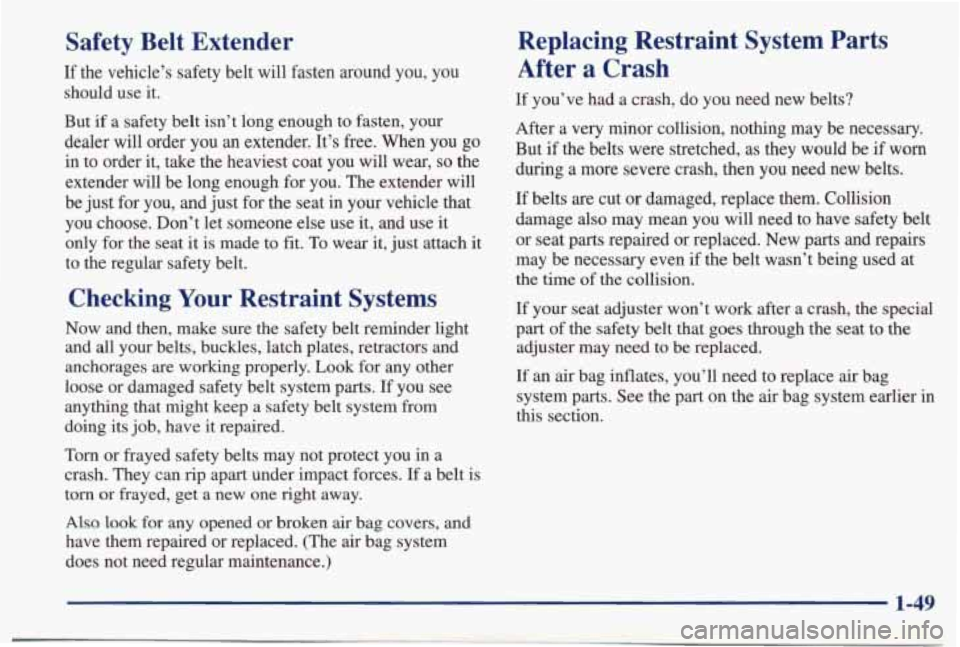
Safety Belt Extender
If the vehicle’s safety belt will fasten around you, you
should use it.
But if a safety belt isn’t long enough to fasten, your
dealer will order you
an extender. It’s free. When you go
in to order it, take the heaviest coat you will wear,
so the
extender will be long enough for you. The extender will
be just for you, and just for the seat in your vehicle that
you choose. Don’t let someone else use it, and use it
only for the seat
it is made to fit. To wear it, just attach it
to the regular safety belt.
Checking Your Restraint Systems
Now and then, make sure the safety belt reminder light
and all your belts, buckles, latch plates, retractors and
anchorages are working properly. Look for any other
loose or damaged safety belt system parts.
If you see
anything that might keep a safety belt system from
doing its job, have it repaired.
Tom or frayed safety belts may not protect you in a
crash. They can rip apart under impact forces.
If a belt is
torn or frayed, get a new one right away.
Replacing Restraint System Parts
After a Crash
If you’ve had a crash, do you need new belts?
After a very minor collision, nothing may be necessary.
But
if the belts were stretched, as they would be if worn
during a more severe crash, then you need new belts.
If belts are cut or damaged, replace them. Collision
damage also may mean you will need to have safety belt or seat parts repaired or replaced. New parts and repairs
may be necessary even if the belt wasn’t being used at
the time of the collision.
If your seat adjuster won’t work after a crash, the special
part of the safety belt that goes through the seat to the
adjuster may need to be replaced.
If
an air bag inflates, you’ll need to replace air bag
system parts. See the part on the
air bag system earlier in
this section.
Also look for any opened or broken air bag covers, and
have them repaired or replaced. (The
air bag system
does not need regular maintenance.)
Page 58 of 395
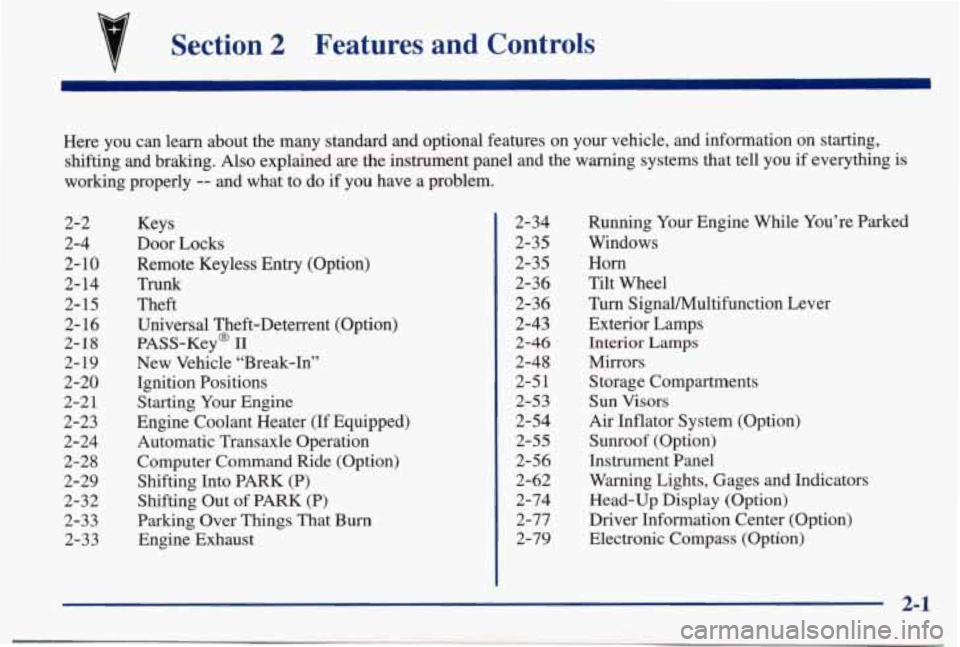
Section 2 Features and Controls
Here you can learn about the many standard and optional featur\
es on your vehicle, and information on starting,
shifting and braking.
Also explained are the instrument panel and the warning systems that tell you if everything is
working properly
-- and what to do if you have a problem.
2-2
2-4 2-
10
2- 14
2-15
2-16
2-18
2- 19
2-20
2-21
2-23
2-24
2-28
2-29 2-32
2-33 2-33 Keys
Door Locks
Remote Keyless Entry (Option)
TnXnk
Theft
Universal Theft-Deterrent (Option)
PASS-Key@
I1
New Vehicle “Break-In”
Ignition Positions
Starting
Your Engine
Engine Coolant Heater (If Equipped) Automatic Transaxle Operation
Computer Command Ride (Option)
Shifting Into PARK (P)
Shifting Out
of PARK (P)
Parking Over Things That Burn Engine Exhaust 2-34
2-35
2-35
2-36
2-36
2-43
2-46
2-48 2-5
1
2-53
2-54
2-55
2-56 2-62
2-74
2-77
2-79 Running
Your Engine While You’re Parked
Windows Horn
Tilt Wheel
Turn SignaYMultifunction Lever
Exterior Lamps
Interior Lamps
Mirrors Storage Compartments
Sun Visors
Air Inflator System (Option)
Sunroof (Option)
Instrument Panel
Warning Lights, Gages and Indicators Head-Up Display (Option)
Driver Information Center (Option)
Electronic Compass (Option)
2-1
Page 72 of 395
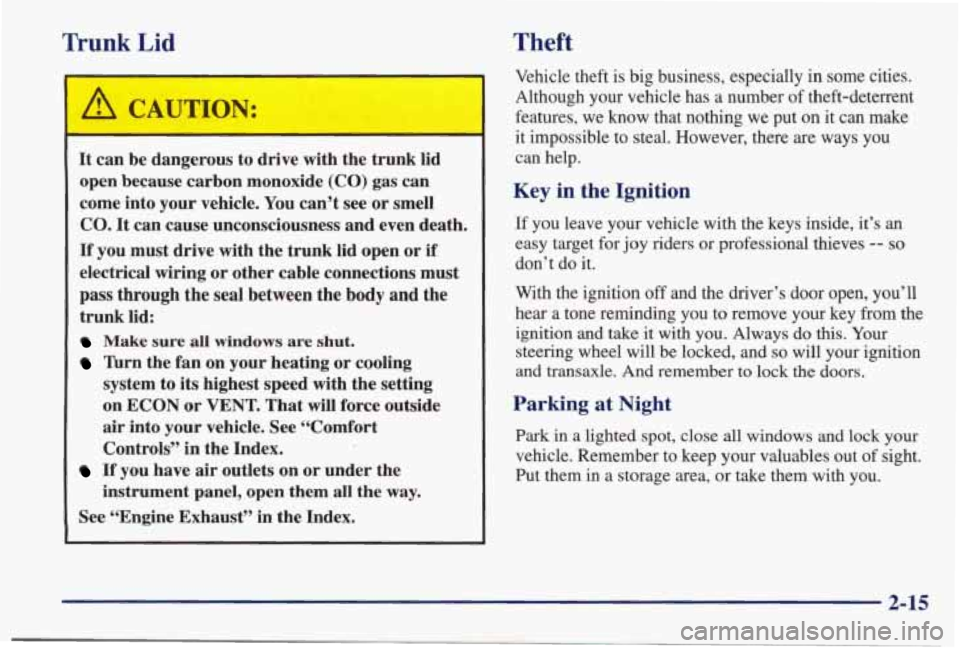
Trunk Lid
I
It can be dangerous to drive with the trunk lid
open because carbon monoxide
(CO) gas can
come into your vehicle. You can’t see or smell
CO. It can cause unconsciousness and even death.
If you must drive with the trunk lid open or if
electrical wiring or other cable connections must
pass through the
seal between the body and the
trunk lid:
Make sure all windows are shut.
Turn the fan on your heating or cooling
system to its highest speed with the setting
on ECON or VENT. That will force outside
air into your vehicle. See “Comfort
Controls”
in the Index.
If you have air outlets on or under the
instrument panel, open them
all the way.
See “Engine Exhaust” in the Index.
I
Theft
Vehicle theft is big business, especially in some cities.
Although your vehicle has a number of theft-deterrent
features, we know that nothing we put
on it can make
it impossible to steal. However, there are ways you
can help.
Key in the Ignition
If you leave your vehicle with the keys inside, it’s an
easy target for joy riders or professional thieves -- so
don’t do it.
With the ignition
off and the driver’s door open, you’ll
hear a tone reminding you to remove your key from the
ignition and take it with you. Always do this. Your
steering wheel will be locked, and
so will your ignition
and transaxle. And remember to lock
the doors.
Parking at Night
Park in a lighted spot, close all windows and lock your
vehicle. Remember to keep your valuables out of sight.
Put them in a storage area, or take them with you.
2-15
Page 73 of 395
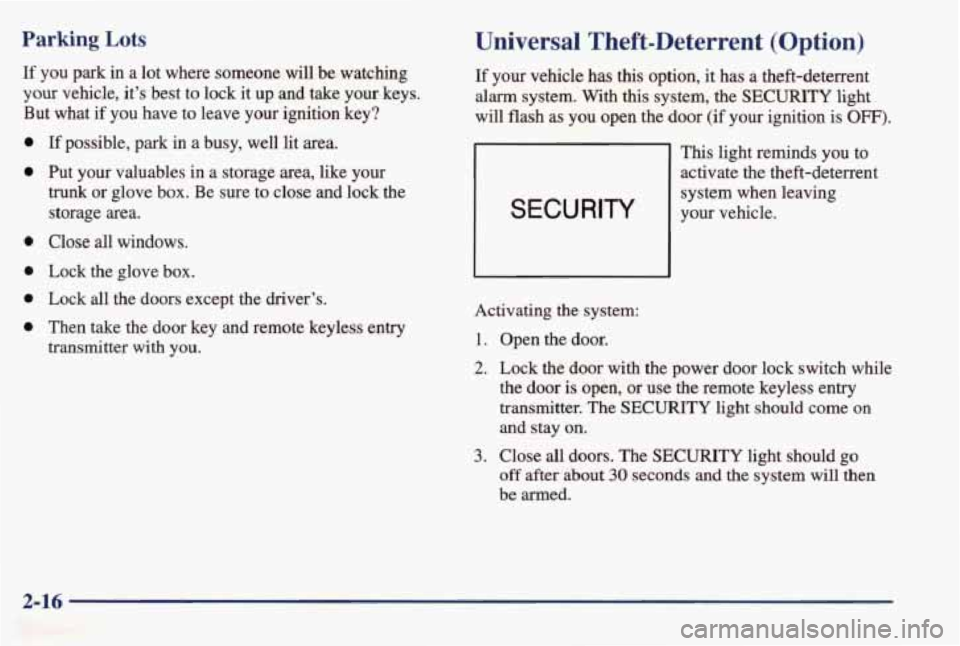
Parking Lots
If you park in a lot where someone will be watching
your vehicle, it’s best to lock it up and take your keys.
But what if you have to leave your ignition key?
0 0
0
0
0
0
If possible, park in a busy, well lit area.
Put your valuables in a storage area, like your
trunk or glove box. Be sure to close and lock the
storage area.
Close all windows.
Lock the glove
box.
Lock all the doors except the driver’s.
Then take the door key and remote keyless
entry
transmitter with you.
Universal Theft-Deterrent (Option)
If your vehicle has this option, it has a theft-deterrent
alarm system. With this system, the SECURITY light
will flash as you open the door (if your ignition is OFF).
SECURITY
This light reminds you to
activate the theft-deterrent
system when leaving
your vehicle.
Activating the system:
1. Open the door.
2. Lock the door with the power door lock switch while
the door is open,
or use the remote keyless entry
transmitter. The
SECURITY light should come on
and stay
on.
3. Close all doors. The SECURITY light should go
off after about 30 seconds and the system will then
be armed.
2-16
Page 74 of 395
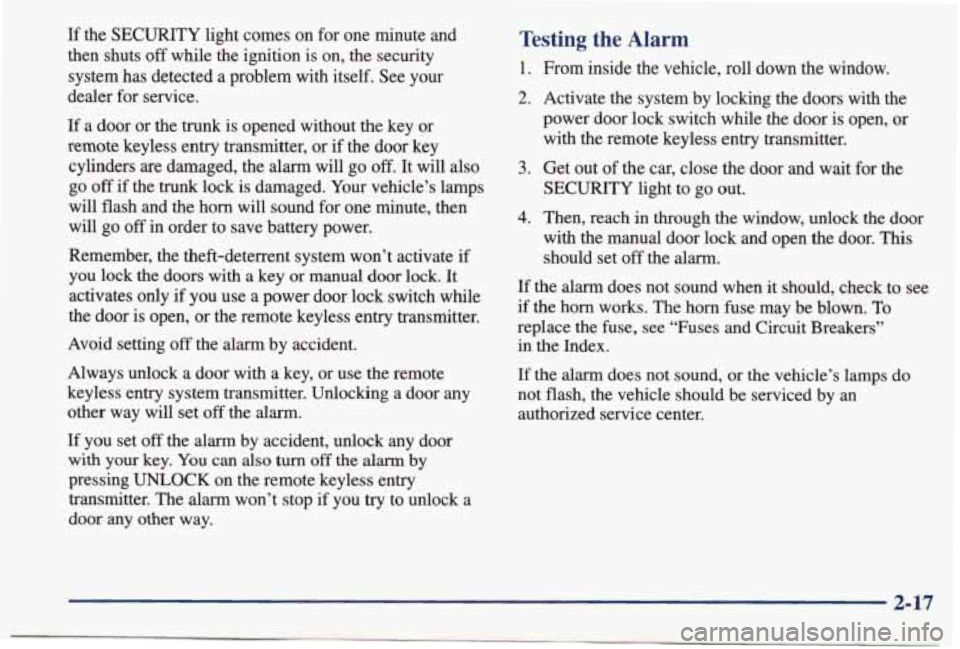
If the SECURITY light comes on for one minute and
then shuts
off while the ignition is on, the security
system has detected a problem with itself. See your
dealer for service.
If a door or the trunk is opened without the key or
remote keyless entry transmitter, or if the door key
cylinders are damaged, the alarm will go
off. It will also
go
off if the trunk lock is damaged. Your vehicle’s lamps
will flash and the horn will sound for one minute, then
will go off in order to save battery power.
Remember, the theft-deterrent system won’t activate
if
you lock the doors with a key or manual door lock. It
activates only
if you use a power door lock switch while
the door is open, or the remote keyless entry transmitter.
Avoid setting
off the alarm by accident.
Always unlock
a door with a key, or use the remote
keyless entry system transmitter. Unlocking
a door any
other way will set
off the alarm.
If you set off the alarm by accident, unlock any door
with your key. You can also turn off the alarm by
pressing UNLOCK on the remote keyless entry
transmitter. The alarm won’t stop if you
try to unlock a
door any other way.
Testing the Alarm
1. From inside the vehicle, roll down the window.
2. Activate the system by locking the doors with the
power door lock switch while the door is open, or
with the remote keyless
entry transmitter.
3. Get out of the car, close the door and wait for the
SECURITY light to
go out.
4. Then, reach in through the window, unlock the door
with the manual door lock and open the door.
This
should set off the alarm.
If the alarm does not sound when it should, check to see
if the horn works. The horn fuse may be blown.
To
replace the fuse, see “Fuses and Circuit Breakers”
in the Index.
If the alarm does not sound,
or the vehicle’s lamps do
not flash, the vehicle should be serviced by an authorized service center.